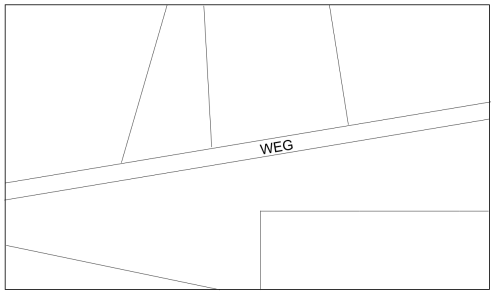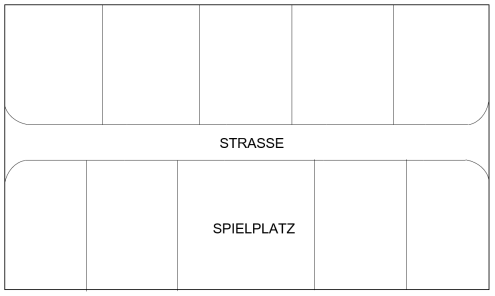Reallocation procedure
About the procedure
Have you ever wondered what a reallocation procedure is? As part of a legally regulated land readjustment procedure in accordance with the German Building Code, the redistribution committee of the city of Bocholt can reorganise developed and undeveloped plots of land for the development or redesign of areas in such a way that the location, shape and size of the plots are appropriately designed for building or other use.
Before the reallocation

The ownership structure does not yet permit utilisation in accordance with the new development plan.
After the reallocation

As part of the reallocation process, the infrastructure areas are transferred to the ownership of the city. The owners receive fully parcelled building plots with payment of a monetary compensation.
Further information
Basic information
Building land developments are regularly accompanied by land reorganisation measures. The reallocation of building land as a legally regulated property exchange procedure (land readjustment procedure) guarantees a careful, fair and speedy reorganisation of future building land. The reorganisation of property is carried out by the reallocation committee of the city of Bocholt. The reallocation committee uses the services of an office located in the property and land management department.
The basis for a reallocation procedure is usually a development plan(currently being drawn up). All property owners involved contribute land, most of which has the value "Gross raw building land". As part of the reallocation, the infrastructure areas required for building land development (traffic and green areas) are generally transferred to the ownership of the city. This so-called area deduction is borne jointly and severally by all participating property owners in equal shares (in proportion to their own land).
As part of the reallocation, the owners are allocated net raw building land in the form of fully parcelled building plots (subject to development charges).
Once the reorganisation has been completed, the owners have to pay a so-called monetary compensation. The monetary compensation essentially corresponds to the savings on surveying, notary and land registry fees.
At the end of the reorganisation process, each owner receives building land at least at the market value that their property had at the start of the reorganisation process.
Equal treatment of all owners is guaranteed by this legally regulated procedure.
Procedure
The process of a reallocation procedure is regulated in sections 45 - 84 of the German Building Code. The procedure provides several opportunities for the parties involved to obtain information, make their own suggestions and, if necessary, lodge corresponding appeals.
The procedure is set in motion with the reallocation order (Section 46 BauGB), which is adopted by the municipal council. To a certain extent, this is a "work order" addressed to the reallocation body and the reallocation committee. The order is usually issued at the same time as the council's decision to initiate a development plan procedure for the area in question.
After hearing the affected property owners, the reallocation procedure is initiated.
The procedure itself is initiated with the reallocation decision (§ 47 BauGB). A reallocation note is entered in the land register for the affected properties. From now on, the municipality has a statutory right of first refusal as well as a disposition and change ban (§ 51 BauGB).
An inventory map and an inventory are made available to the public for a period of one month. The aim is to identify all owners and other interested parties (e.g. holders of rights affecting the properties) whose rights are not evident from the land register.
This is followed by discussions between the reallocation office and the property owners. Where possible, the wishes and suggestions of the owners should be recorded and taken into account when drawing up the draft apportionment plan. The draft apportionment plan is usually drawn up in parallel with the development plan and is discussed with the owners in advance (Section 66 BauGB).
The reorganisation of the properties is shown in a reallocation plan. This consists of a map and a directory and shows the new ownership structure. All parties involved receive an extract relating to their rights.
If no appeals are lodged against the reallocation plan or a final decision has been made on them, the reallocation plan comes into force by public announcement of its incontestability (Section 71 BauGB).
Subsequently, the cadastre and land register as well as the register of building encumbrances are corrected/updated accordingly. In addition, the monetary settlements are now due. The reallocation notes in the land registers are cancelled and the reallocation is thus completed.
Principles of reallocation
The following principles must be observed during reallocation:
-
Principle
- of expediency: Entire areas should be redeveloped or reorganised in an expedient manner.
- The plots themselves should be designed in such a way that they can be utilised appropriately in accordance with the provisions of the development plan. Principle
- of proportionality and equalisation of burdens: All owners are allocated building plots in proportion to their share of the area.
- They also share in the burden (infrastructure areas) in proportion to their shares. Principle
- of private utility and preservation of ownership: The primary aim of reallocation is always to provide building plots to private owners. Principle
- of equality of location: Where possible, owners receive plots in the same or equivalent location. Principle
- of equality of value: Owners receive building plots whose value corresponds to that of the plots of land allocated.
- Unavoidable, usually relatively small differences in value are compensated in cash.
Members of the reallocation committee
The reallocation committee is an independent body, not bound by instructions, consisting of three external experts (i.e. not employed by the city) and two council members.
The experts are
- Chairman: Ralf Groß-Holtick, City Planning Officer, City of Gronau (Deputy Chairman: Dr. Ansgar Hörster, District Director, District of Borken) As
- valuation expert: Manfred Wewers, Head of Surveying and Cadastre Department, District of Coesfeld (Deputy: Nicole Johann, Technical Councillor, City of Voerde) As
- surveying expert: Sebastian Walzog, Head of Geoinformation and Property Cadastre Department, District of Borken (Deputy: Sonja Koppers, Head of Surveying Department, City of Moers)
The councillors who are members of the reallocation committee (and their deputies) can be found here!
The office of the reallocation committee, which is part of the city administration, is responsible for the technical handling of the reallocation procedure and works in accordance with the instructions of the reallocation committee.




